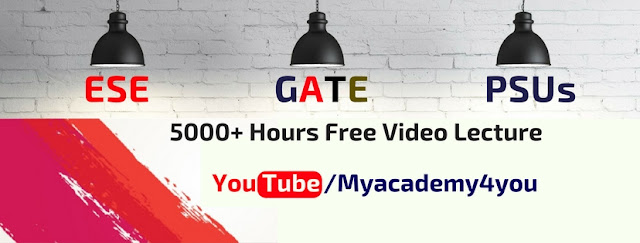Railtel Assistant Engineer Syllabus For ECE
Exam Pattern
Selection will be done in the two-phase written test followed by the interview process. Shortlisted candidate in the written test will be called for the interview.
Written Test:-
Written Test- 2 hours
Number of Question- 100.
Section A- 60 -Technical Question.
1.Basic Electronics Engineering
1. Basics of semiconductors.
Diode/Transistor basics and characteristics.
Diodes for different uses.
Junction & Field Effect Transistors (BJTs, JFETs, MOSFETs).
Transistor amplifiers of different types, oscillators, and other circuits; Basics of Integrated Circuits (ICs).
Bipolar, MOS, and CMOS ICs; Basics of linear ICs, operational amplifiers and they're applications-linear/non-linear.
Optical sources/detectors.
Basics of Optoelectronics and its applications.
Electrical power sources- basics: hydroelectric, thermal, nuclear, wind, solar; Basics of batteries, and their uses.
4. Analog and Digital Communication Systems
5. Control Systems
2. Basic Electrical Engineering
DC circuits ohm's & Kirchoff’s laws, mesh and nodal analysis, circuit theorems; Electromagnetism, Faraday’s & Lenz’s laws, induced EMF and its uses; Single-phase AC circuits.
Transformers, efficiency; Basics-DC machines, induction machines, and synchronous machines.
3. Network Theory
Network graphs & matrices. Wye-Delta transformation
Linear constant coefficient differential equations- time-domain analysis of RLC circuits; Solution of network equations using Laplace transforms- frequency domain analysis of RLC circuits.
2-port network parameters-driving point & transfer functions; State equations for networks.
Steady-state sinusoidal analysis.
4. Analog and Digital Communication Systems
Random signals, noise, probability theory. Information theory.
Analog versus digital communication & applications.
Systems- AM, FM, transmitters, receivers, theory, practice, standards, SNR comparison,
Digital communication basics.
Sampling, quantizing, coding, PCM, DPCM, multiplexing-audio/video.
Digital modulation: ASK, FSK, PSK.
Multiple access: TDMA, FDMA, CDMA.
5. Control Systems
Classification of signals and systems.
Application of signal and system theory.
System realization; Transforms& their applications.
Signal flow graphs, Routh-Hurwitz criteria, root loci, Nyquist/Bode plots.
Feedback systems-open &close loop types, stability analysis, steady-state, transient, and frequency response analysis.
Design of control systems, compensators, elements of lead/lag compensation, PID, and industrial controllers.
6. Digital Electronics
Boolean algebra, minimization of Boolean functions; logic gates; digital IC families (DTL, TTL, ECL, MOS, CMOS).
Combinatorial circuits: arithmetic circuits, code converters, multiplexers, decoders, PROMs, and PLAs.
Sequential circuits: latches and flip-flops, counters, and shift-registers. Sample and hold circuits, ADCs, DACs. Semiconductor memories.
A microprocessor (8085): architecture, programming, memory, and I/O interfacing
7.Microprocessors & microcontrollers-
Basics, interrupts, DMA, instruction sets, interfacing; Controllers.
Basics, interrupts, DMA, instruction sets, interfacing; Controllers.
8. Advanced Communication.
Communication networks: Principles /practices /technologies /uses /OSI model/security.
Basic packet multiplexed streams/scheduling. Cellular networks, types, analysis, protocols (TCP/TCPIP).
9. Optical Fiber Communication
Overview of optical fiber communication:- The general system, Advantages of optical fiber communication, Optical spectral band.
Optical Fiber waveguides: Introduction, Ray theory transmission Total internal reflection, acceptance angle, numerical aperture, skew rays.
Electromagnetic mode theory for optical propagation: Electromagnetic waves, modes in a planar guide, phase and group velocity, phase shift with total internal reflection and the evanescent field, goos hanchen shift.
10. Signal System
Definitions and properties of Laplace transform, continuous-time and discrete-time Fourier series.
Continuous-time and discrete-time Fourier Transform, DFT and FFT, z-transform. Sampling theorem.
Linear Time-Invariant (LTI) Systems: definitions and properties; causality, stability, impulse response, convolution, poles and zeros, parallel and cascade structure, frequency response, group delay, phase delay.
Signal transmission through LTI systems.
11. Network Switching Theory
Telecommunications Transmission: Basic Switching System, Simple Telephone
Communication, the evolution of switching systems -Stronger switching systems Switching Used in telecommunications crossbar switching,
Electronic Switching – Space Division, Switching,
Time Division Switching –Time Division space switching, Time Division Time Switching, Time multiplexed space switching, Time multiplexed Time Switching, Combination Switching
Control of Switching Systems: Call processing functions, common control, stored program control (For all types of switching systems)
Elements of vector calculus: divergence and curl; Gauss’ and Stokes’ theorems,
Maxwell’s equations: differential and integral forms. Wave equation, Poynting vector. Plane waves: propagation through various media; reflection and refraction; phase and group velocity; skin depth.
Transmission lines: characteristic impedance; impedance transformation; Smith chart; impedance matching; S parameters, pulse excitation.
Waveguides: modes in rectangular waveguides; boundary conditions; cut-off frequencies; dispersion relations.
Section B – 40 – Non-Technical Question.
Syllabus-
1. General Awareness
2. Quantitative Aptitude
3. Logical Reasoning
4. General English
Note- Railtel Exam Question of Previous Year is very simple means a basic question of all the above subjects like other PSUs Exam.
Best Of Luck
Thank You For Reading
Please Subscribe Myacademy Youtube Channel
Visit- Our Other Article


Post a Comment